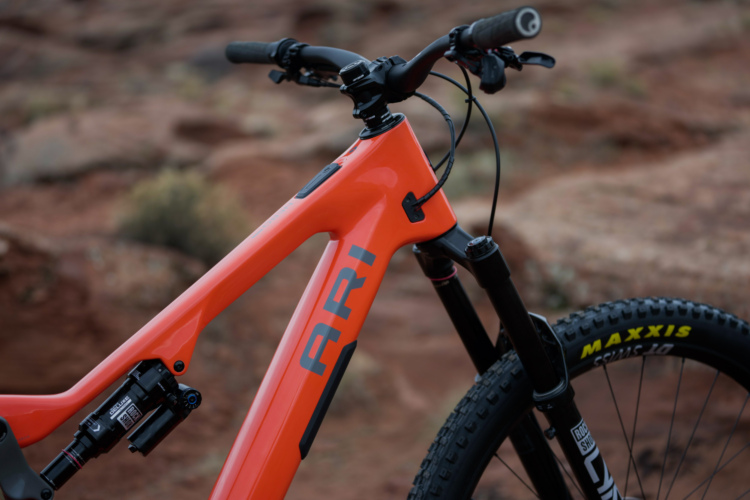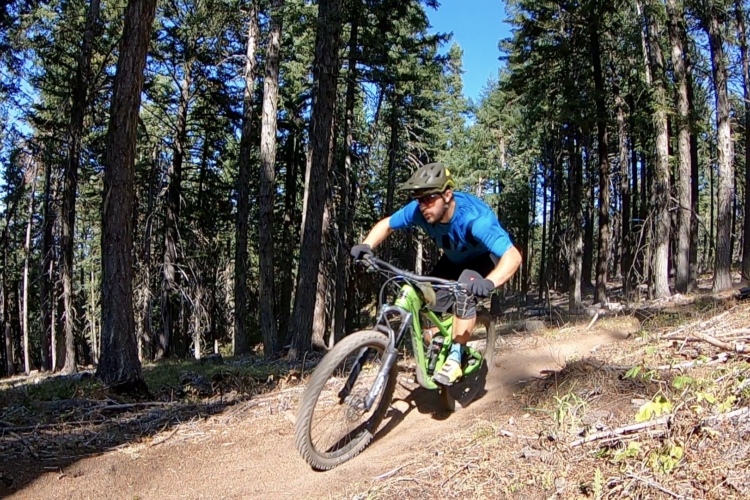Looking at the photo above you might be thinking: are these Avid Codes?!? Yup they sure are. Totally revamped and improved for 2011 and you can see the difference right away. Gone is the clunky over-sized design; instead, the new Codes feature a sleek, lightweight profile that is very close in concept to the rest of the Avid brake line up. Fortunately the Codes keep many of the unique features that make them durable and reliable enough for gravity riders.
Crashing is inevitable for those who ride the slopes at high speed and the new Avid Code brake levers still feature the “Bend Zone” that allows the lever to flex which prevents damage to the lever body. The new levers also feature the same ultra-durable, 3-cartridge bearing pivot system as the previous generation Codes.
The 2011 Code system weighs in at 410 grams for the 160mm post mount version and the updated lever sports the same Taperbore technology as the rest of the 2011 Avid brake line-up. The integrated reservoir and pad contact adjustment is also featured on the new Codes as is an adjustable reach knob (shown above). The adjustable reach option is a wise addition to the brake since DH riders often have widely varying preferences for lever-to-bar distances. The new finish and graphics are something to behold – the whole set-up almost looks like surgical equipment!
The new Avid Codes still utilize a four piston caliper but this time around they feature a top loading pad (my personal favorite feature on a brake – other than stopping) and a caliper that has had a bit of the fat trimmed off with an adjustable banjo for that perfect fit. The caliper is a forged 2-piece unit that uses two bridge bolts compared to the four bolts that were used in previous versions. Thanks to the re-design, the new caliper is just as stiff or even stiffer. For friction material you’re getting a steel backing plate with organic linings which makes for a quieter brake. Inside, the brakes are running on DOT 5.1 fluid which keeps things crisp with great modulation. The Tri-align mounting system is perfect for frames that may not be perfectly straight and allows you to install the brakes in a fraction of the time it might normally take.
Speaking of installation, you get everything you need for each brake (front and rear) – just make sure to order the correct version for your needs and application. Although the calipers and levers are the same for front and rear, the hose lengths, rotors, and adapters are different. My set (shown above) came with front and rear 203mm G3 Cleansweep rotors. Following the easy instructions from Avid (these seem to get better every year), make sure you pay attention to the rotor bolt “star” installation section. Torque the T25 bolts down with a torque wrench and your rotor is good to go.
Following that, install the adapters as needed, and torque them in place. Finally, you’re ready to install the brakes to your bike. You can either fasten down the caliper or the levers first; I like to start with the calipers so I can run the cables exactly the way I want. Install the CPS caliper hardware loosely at first and run the cables up to the bars, fastening them to the frame with cable ties. [Side note: I used to love those snaps that some frames come with until mine popped off at the wrong time and I got a hose torn off. Lesson learned.] Now, at the bar end it’s just a matter of setting the correct angle and spacing, fastening the split clamp down with the supplied stainless steel hardware and torquing everything in place. Lastly, if necessary, shorten the hose.
The chart below shows the subjective brake performance of the new 2011 Avid Codes.
Once all that assembly stuff was out of the way I had to take these brakes out on the trail. This time around I installed the brakes on a brand new bike – my Banshee Legend II project bike – so I really didn’t know what to expect. Having ridden the older Codes (and honestly not liking them), I had a dim view of what was to come.
After putting these brakes to the test I’m happy to say the new Codes ride very differently than the older units. Avid really improved the brakes’ modulation – previous models worked more like on/off switches in many cases. I guess the revamped lever was part of the trick. Now when I ride I can play with the lever a bit to better control the wheel and I can still stop the bike in a hurry. After burnishing the pads I found I got surprisingly high levels of stopping power.
I also got a nice feel throughout the stroke when applying the brakes. At first contact there seems to be a very quick build of friction and stopping power with a high amount of torque. In some cases I found that I had to ease off the lever a touch as torque continued to build from the pads heating up. The second I got off the lever, the release was immediate with zero drag. Doing this often on some other brakes often leads to brake fade. Even over long runs the lever never went mushy. The Codes are definitely “one-finger brakes” thanks to the high braking forces – perfect for those of us who love gravity, are on the heavier side, or are just plain hard on our brakes.
Overall the 2011 Avid Code brakes ($235 MSRP) are impressive and offer a big upgrade over previous generations. Improved modulation, durable construction, and consistent performance make these a great choice for anyone who rides hard.
Thanks to the folks at Avid for sending down these brakes for a review.



























8 Comments
Feb 5, 2013
Thanks for the review, with the cost of these brakes the review really helped me make my decision with confidence.
Jan 5, 2011
It seems like the biggest complaints I've heard with Avids are the noise (i.e. squeaking). How are these in that respect?
Are these strictly geared toward gravity riders. In other words, is this too much brake for a more cross country style of riding? What about agressive cross country?
Btw, thanks for the review.
Jan 7, 2011
Jan 5, 2011
Burnishing the pads is basically a few stops ( I usually go at a high speed and come nearly to a complete stop a few times) that mates the pads to the rotors. Not scuffing them up with sand paper...Anyhow that makes the pads work better. With squeeking that could be a misaligned caliper or gunk that can build up on the pads. Usually cleaning them up with fine sand paper (the rotors as well) and then cleaning them off with bike brake cleaner. Followed by a burnishing sequence will get them working right again. Typically after that procedure I will re-allign the caliper once again..
As far as for too much brake ....Ummm for an XC guy. you could use the XO or X9 they have plenty of stopping power...OR go for the Code R which are a bit lighter weight...Same caliper just differnt lever..
Jan 5, 2011
As far as burnishing, the user manual calls this procedure "bed-in" and says this:
"Remain seated on the bike during the entire bed-in procedure. Accelerate the bike to a moderate speed, then firmly apply the brakes until you are at walking speed. Repeat approx. 20 times. Next, accelerate the bike to a faster speed. Then very firmly and suddenly apply the brakes until you are at walking speed. Repeat approx. 10 times. Important: do not lock up the wheels at any time during the procedure. Allow the brakes to cool prior to any additional riding."
Jan 5, 2011
Am I the only one that thinks Avid has TOO MANY brakes now? They seem to have a bunch that are all very similar.
Jan 7, 2011
Nov 2, 2011